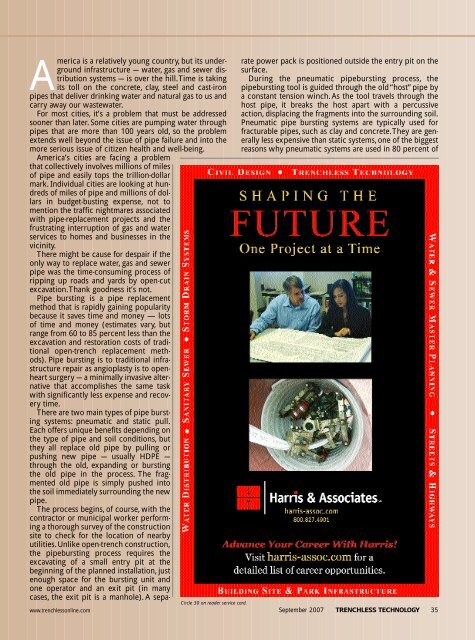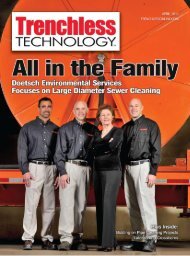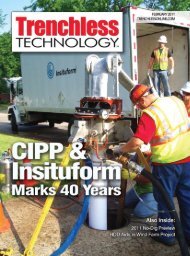Author: Professor, Dr. Dietrich Stein - TrenchlessOnline
Author: Professor, Dr. Dietrich Stein - TrenchlessOnline
Author: Professor, Dr. Dietrich Stein - TrenchlessOnline
Create successful ePaper yourself
Turn your PDF publications into a flip-book with our unique Google optimized e-Paper software.
America is a relatively young country, but its underground<br />
infrastructure — water, gas and sewer distribution<br />
systems — is over the hill.Time is taking<br />
its toll on the concrete, clay, steel and cast-iron<br />
pipes that deliver drinking water and natural gas to us and<br />
carry away our wastewater.<br />
For most cities, it’s a problem that must be addressed<br />
sooner than later. Some cities are pumping water through<br />
pipes that are more than 100 years old, so the problem<br />
extends well beyond the issue of pipe failure and into the<br />
more serious issue of citizen health and well-being.<br />
America’s cities are facing a problem<br />
that collectively involves millions of miles<br />
of pipe and easily tops the trillion-dollar<br />
mark. Individual cities are looking at hundreds<br />
of miles of pipe and millions of dollars<br />
in budget-busting expense, not to<br />
mention the traffic nightmares associated<br />
with pipe-replacement projects and the<br />
frustrating interruption of gas and water<br />
services to homes and businesses in the<br />
vicinity.<br />
There might be cause for despair if the<br />
only way to replace water, gas and sewer<br />
pipe was the time-consuming process of<br />
ripping up roads and yards by open-cut<br />
excavation.Thank goodness it’s not.<br />
Pipe bursting is a pipe replacement<br />
method that is rapidly gaining popularity<br />
because it saves time and money — lots<br />
of time and money (estimates vary, but<br />
range from 60 to 85 percent less than the<br />
excavation and restoration costs of traditional<br />
open-trench replacement methods).<br />
Pipe bursting is to traditional infrastructure<br />
repair as angioplasty is to openheart<br />
surgery — a minimally invasive alternative<br />
that accomplishes the same task<br />
with significantly less expense and recovery<br />
time.<br />
There are two main types of pipe bursting<br />
systems: pneumatic and static pull.<br />
Each offers unique benefits depending on<br />
the type of pipe and soil conditions, but<br />
they all replace old pipe by pulling or<br />
pushing new pipe — usually HDPE —<br />
through the old, expanding or bursting<br />
the old pipe in the process. The fragmented<br />
old pipe is simply pushed into<br />
the soil immediately surrounding the new<br />
pipe.<br />
The process begins, of course, with the<br />
contractor or municipal worker performing<br />
a thorough survey of the construction<br />
site to check for the location of nearby<br />
utilities.Unlike open-trench construction,<br />
the pipebursting process requires the<br />
excavating of a small entry pit at the<br />
beginning of the planned installation, just<br />
enough space for the bursting unit and<br />
one operator and an exit pit (in many<br />
cases, the exit pit is a manhole). A sepa-<br />
www.trenchlessonline.com<br />
Circle 30 on reader service card.<br />
rate power pack is positioned outside the entry pit on the<br />
surface.<br />
During the pneumatic pipebursting process, the<br />
pipebursting tool is guided through the old “host” pipe by<br />
a constant tension winch. As the tool travels through the<br />
host pipe, it breaks the host apart with a percussive<br />
action, displacing the fragments into the surrounding soil.<br />
Pneumatic pipe bursting systems are typically used for<br />
fracturable pipes, such as clay and concrete.They are generally<br />
less expensive than static systems,one of the biggest<br />
reasons why pneumatic systems are used in 80 percent of<br />
September 2007 TRENCHLESS TECHNOLOGY 35








